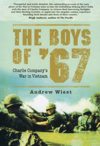Vietnam War the World of Charlie Company Reviews
 The Boys of '67: Charlie Company's War in Vietnam, by Andrew Wiest, Osprey, 2012
The Boys of '67: Charlie Company's War in Vietnam, by Andrew Wiest, Osprey, 2012
As Major General William Tecumseh Sherman famously observed, "State of war is hell." Yet information technology is as well a profoundly man affair with the power to remake men. Nowhere is this inalienable truth more evident than in Andrew Wiest'south riveting tale that chronicles the transformation of Charlie Visitor, fourth Battalion of the 47th Infantry, 9th Infantry Partitioning, from a seemingly disparate rabble to a hardened ring of brothers.
Concerned with the apparent resurgence of the Viet Cong (VC) in the strategically vital Mekong Delta, Military Assistance Control, Vietnam (MACV) planners in 1965 began exploring the possibility of basing U.S. infantry in the region and eventually proposed wedding naval vessels with regular army infantry. Highly mobile, this articulation Army/Navy forcefulness would base troops on ships and bear operations to oppose VC control of the Delta and its numerous waterways.
In Feb 1966, the ninth ID was reactivated and ultimately tabbed to serve as the infantry component of the Mobile Adrift Force, later renamed the Mobile Riverine Forcefulness (MRF). Naturally the newly reactivated 9th—the only sectionalization "raised, drafted, and trained for service in Vietnam"—needed men to mankind out its burgeoning ranks, and that May draft-eligible young men across the country received telegrams instructing them to report for induction into the Military of the United States. Thus was Charlie Company, quaternary of the 47th Infantry "born."
Shuffled off to Ft. Riley, Kan., for months of military training—which, incidentally, would swallow the subordinate units of the ninth ID until the division deployed to Vietnam—the young draftees were asked to coexist in a remarkably heterogeneous outfit. Racially and culturally various, Charlie Company featured soldiers from near every walk of life. Pacifists and class clowns served with patriotic idealists, just as blackness kids from the segregated South soldiered aslope longhaired white surfer boys from the California coast. "Everyone was there in the newly raised visitor," writes Wiest, including "the nerdy guy…the gung-ho true believers…the everyman who just wanted to become through unnoticed." Subjected to the constant demands of training, the young troopers quickly realized that they had to bail and piece of work together if they hoped to survive.
But here Wiest delves deeper, weaving the story of the individual into the narrative so artfully that the reader comes to know these soldiers intimately, making it incommunicable not to mourn the loss of each life in the inevitable gainsay to come.
Dispatched to war with the rest of the 9th ID, Charlie Visitor arrived in Vietnam in January 1967 and shortly began combat operations in the Rung Sat Special Zone, a marshy wasteland and VC sanctuary south of Saigon. Naively, some of the Charlie Company boys lamented the lack of early on action, but in the watery mine- and booby-trap-infested Rung Sat, the company sustained its first casualties, and suddenly an empty bunk was all that remained of a once-love buddy. "All innocent thoughts that this was somehow 'non a real state of war' had long since been banished," Wiest explains. Moderated past the loss of their buddies, withal, the originals—the Ft. Riley boys who had been together from the outset—drew closer nevertheless.
Leaving the Rung Sabbatum behind, Charlie Company entered the volatile Mekong Delta in earnest in May 1967, only to tangle with large Viet Cong units in battles as violent, if not every bit famous, as some of the more celebrated clashes of the war. Every bit the losses mounted and a steady influx of replacements slowly inverse the composition of the company, the remaining originals resolved to fight even harder to bring one some other domicile alive.
Wiest, a professor of history at Southern Mississippi Academy, also recounts the unique manner in which Charlie Company, every bit an element of the MRF, operated. Converted WWII-era landing craft, for instance, served as the primary means of troop transport to and from boxing, and the company frequently billeted aboard floating barracks ships (Mobile Riverine Base) while on operations.
Nonetheless, it is Wiest's extraordinarily human account of immature men suffering, fighting and mourning every bit one, coupled with the role that those brave men played in the evolution of the MRF, that distinguish The Boys of '67 from other books in the genre.
—Warren Wilkins
Originally published in October 2012 result, Vietnam magazine.
Source: https://www.historynet.com/review-the-boys-of-67-charlie-companys-war-in-vietnam/
0 Response to "Vietnam War the World of Charlie Company Reviews"
Postar um comentário